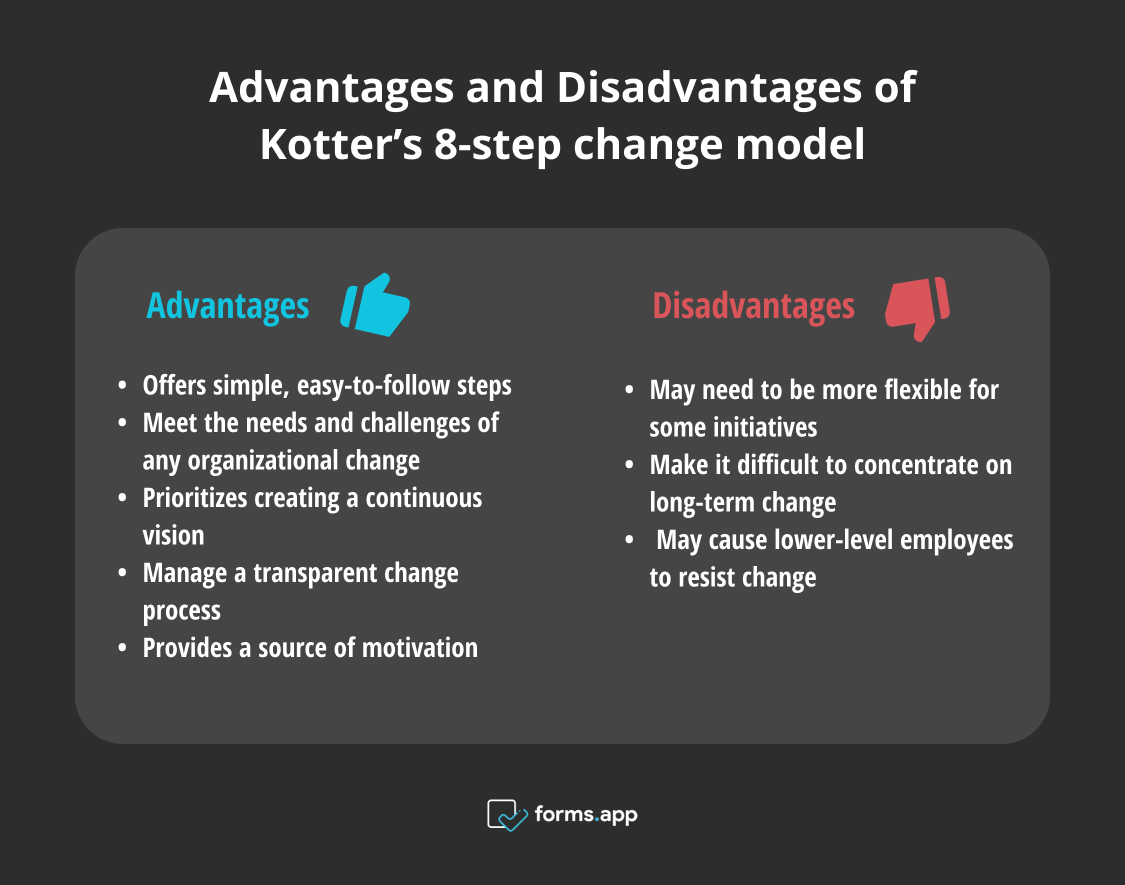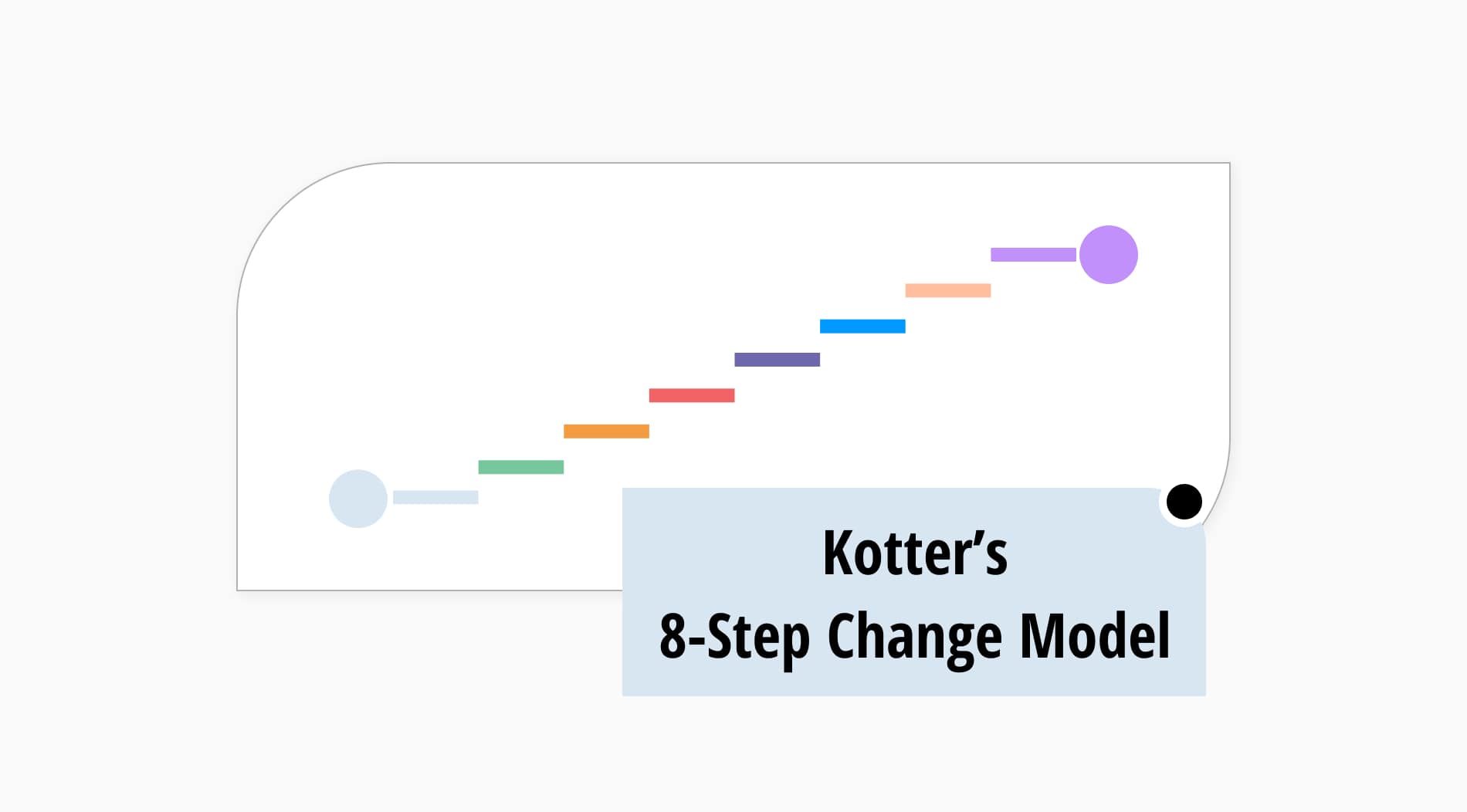The concept of change is an inherent element of existence, from the most minor formations to the largest-scale formations. Heraclitus's saying, "The only constant thing is change," supports this. It is an innovative and continuous phenomenon needed for businesses, companies, and organizations in all areas of life. Change is inevitable if you want to make your company or business successful.
In this article, we prepared a complete guide to Kotter 8 step change model. You can learn everything you are looking for about this change model, its advantages, and disadvantages. Also, you can find the eight steps of this change model involved. Increase your business's chances of success with Kotter's 8 step change model. Let's start!
What is Kotter’s 8-step change model?
John Kotter's 8-step change model diagram is a change management model designed to help businesses, companies, or organizations successfully implement and manage the change process.
This model of change is a prevalent model that is accepted worldwide. According to the model, ensuring continuity in change is possible with leadership, communication, and strategic vision.
Change is an essential element, especially in the context of organizational change. Businesses and organizations should achieve success, remain competitive, and meet the expectations of the age. The study showed that only 30% of organizational changes are successful, while a high failure rate is 70%. The Kotter change model comes into play in this lack of success.
Advantages of Kotter’s 8-step change model
You learned what Kotter's 8-step change model is. So why should you implement this change model? What benefits does using this model bring to your business? We answered these questions for you. Below, you can find the advantages of Kotter's change model:
- It offers simple, clear, and easy-to-follow steps at each stage. This way, you can reduce indecision and uncertainty among employees and key stakeholders during your change initiation process.
- Although the model offers a systematic approach, it can meet the needs and challenges of any organizational change initiative.
- It prioritizes creating a continuous vision and sense of urgency to ensure the adoption and permanence of change. It allows you to convince company employees and stakeholders of the necessity of change.
- The model recommends creating a guiding coalition from different levels and departments that advocates for the need for change. Thus, you can manage a transparent change process that includes multifaceted perspectives through the guiding coalition you create.
- It describes short-term gains as a stepping stone to long-term success. This situation provides a source of motivation for you to achieve permanent and sustainable success.
Disadvantages of Kotter’s 8-step change model
We talked about the advantages of Kotter's change model. So, does this model have any disadvantages? The answer is yes! Although it has advantages that will benefit your business, Kotter's change model also has disadvantages in some cases. Let's take a look at these:
- The model's eight-step, sequential, and systematic approach may need to be more flexible for some initiatives. The change process may not always be linear, as stated in the model, and the steps may not follow each other.
- Focusing on short-term gains may cause employees to think of premature victory. It can make it difficult to concentrate on the process of permanent, long-term change.
- Although the model suggests forming a mixed guiding coalition, companies can ignore it. Failure to create this mixed structure may cause lower-level employees to resist change and not support the process.

Pros and Cons of Kotter’s 8-step change model
Kotter’s 8-step change model
John Kotter argues that change is essential for organizations or institutions. It develops a model of 8 steps to help you succeed with this change. Now, it's time to learn what Kotter's change steps are and how you can implement them.

8-step change model of Kotter
Step 1: Create a sense of urgency
According to Kotter change management, the first step to change is to create a sense of urgency. The entire company must want change to happen and be permanent. Your immediate sense of urgency is a very effective motivation to start this process and persuade people to take action as soon as possible.
Therefore, to initiate an effective change process, what you need to do in this step is to convince at least 75% of the organization's management why the change is necessary. You can provide honest and convincing information about sales statistics and competitors in your target market. You can identify current or potential threats and develop scenarios that include your predictions.
Your efforts in this direction aim to ensure team members understand and support why change is necessary. Thus, the sense of urgency you create is adopted, and the current situation creates dissatisfaction in others. This way, you can complete the first step for a successful change initiative and move on to the next step.
Step 2: Creating a strong and guiding coalition
Even if you have managed to create a sense of urgency, you must continue to work around this need for change for a successful change process. In this step, you can develop a solid coalition to guide your change initiatives and work as a team.
The guiding coalition you create does not have to align with the company hierarchy. Including influential, respected people in your organization and from different departments increases the success and effectiveness of the coalition you create. However, you should carefully build a team with the qualities and skills to lead and influence key stakeholders.
Step 3: Creating a strategic vision
In this step, you should create a clear vision for your company's change initiative. You can also help your team succeed by developing effective strategies. If your change initiatives are successful, the outcome can be a source of motivation for your team members.
However, there are some points you should pay attention to. You must ensure that the vision you create can attract the attention of the company's stakeholders and offer realistic goals. It allows the necessity of change to be more easily understood.
Additionally, your vision should be aligned with your company's core values and the change initiative you want to create. Your change coalition should be able to define the vision in minutes easily. It allows you to develop a vision that people can easily understand and follow.
Step 4: Initiating vision communication
After creating your vision, communicating the vision is another issue that affects the change initiative's success. Your goal in this step is to convey the vision and strategy you have created to the rest of the company powerfully and convincingly. The strength and continuity of your communication significantly affect the acceptance and support of change initiatives.
At this point, you can have frequent, persuasive conversations about your vision for change. You should consider your employees' concerns and demonstrate communication that can address these concerns. You should reassure and persuade your employees by using every communication tool.
Step 5: Removing obstacles
Many direct or indirect obstacles may resist or do not support the change process. In this step, you should remove barriers that slow or disrupt change progress. A guiding coalition you create from different departments and levels can help you remove obstacles through open communication with employees and key stakeholders.
Also, you should integrate your vision for change into the entire organizational process in your company. To achieve this, you can reward and motivate your employees. You can identify what your employees who resist change need and support them with the necessary training. This way, you can increase participation and support for the change initiative.
Step 6: Creating short-term gains
Although the Kotter change model aims for real and long-term change, it may take time to achieve this. You can achieve small successes with short-term goals. The short-term success you achieve creates a sense of victory in your team. This way, you can be motivated to make long-term goals possible.
You should make the most of the pros and cons of your goals. While achieving the goal increases motivation, failing can decrease your team's motivation. Therefore, you should carefully identify attainable and quick wins, such as reducing costs and improving profits.
Step 7: Take advantage of change
💡Remember, short-term gains are just the beginning of long-term change success. Don't get caught up in short-term success and declare a big victory prematurely.
You can use your successes as an opportunity. After your successes, you can determine what you did right and what you need to improve and develop. With this step, you can continue to share the vision and reap the benefits.
Step 8: Consolidating change in corporate culture
In this step, you should focus on making the change permanent and part of the institution. To ensure this, you must ensure the change is visible and adopted on a large scale in every company area. Incorporating all values and norms of the corporate culture into your change organizations helps you ensure permanence.
Last words
Ensuring change is indispensable for companies or organizations to stay up-to-date and succeed. However, it takes work to implement and manage this process successfully. The Kotter model of change can guide you through this challenging process. If you want successful change process management, you must take action.
In this article, we talked about what Kotter's 8-step change model is. We have included the advantages and disadvantages of the model that you can consider. You can also find the 8 steps in the model that allow you to manage a successful change process and what each step includes.
Işılay is a content writer on forms.app. She is passionate about advertising. This passion comes from the fact that she likes to make things interesting for people. She loves reading and writing. Işılay specializes in marketing, survey types, and program management.



